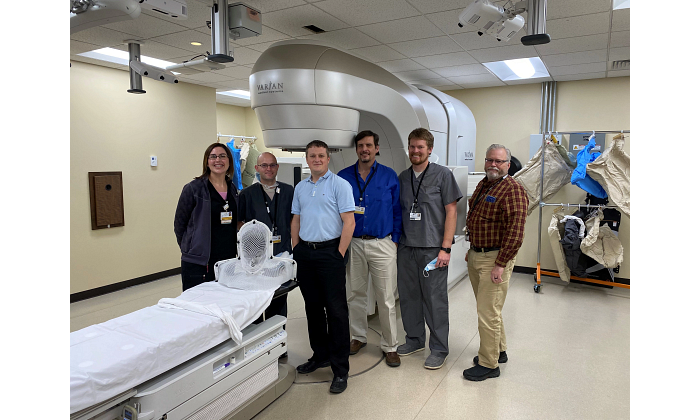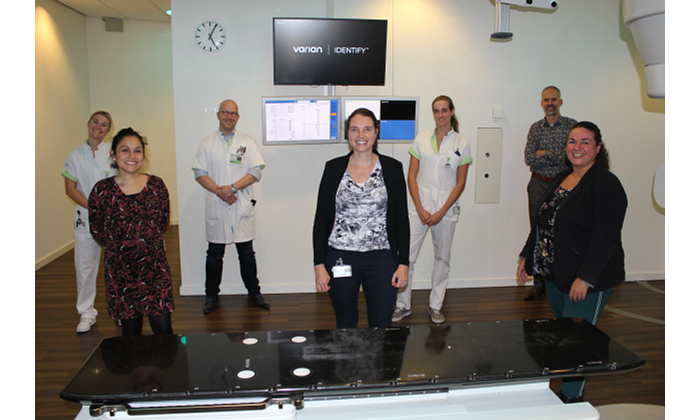Rethinking Patient Safety and Motion Monitoring in Busy Clinics
As part of its ongoing commitment to Intelligent Cancer Care, Varian combines innovation with advances in patient identification, safety, and motion tracking to offer a comprehensive patient guidance system. The Varian IDENTIFY™ system is incorporated within the Varian technology portfolio and helps ensure that all patients gets the treatment meant for them—from patient check-in through setup and treatment.
Since Varian’s release of the latest version of IDENTIFY earlier this year, a number of clinics in the USA and Europe have adopted the system for patient identification and setup, accessory positioning, and motion monitoring. From the beginning of the patient’s journey through the end of treatment, IDENTIFY plays an important role during each step. The system is automated within the Varian ecosystem to integrate within the standard workflow of patient identification, CT acquisition, accessory and patient setup and treatment delivery. IDENTIFY helps to minimize treatment variables and reduces the opportunity for error over the course of a patient’s treatment.
In this article, we take a closer look at how two cancer care centers, one in the USA and the other in the Netherlands, have successfully implemented IDENTIFY to support single-fraction stereotactic radiosurgery (SRS) and Deep Inspiration Breath Hold (DIBH), in order to help increase clinical confidence and improve patient safety.
Intermountain Radiation Oncology Expands Use of IDENTIFY Beyond SRS

Intermountain Radiation Oncology is part of the Teton Cancer Institute, an affiliate of Mountain View Hospital in Idaho Falls, Idaho. This 41-bed off-site facility has been treating up to 45 patients a day using SRS, SBRT, and IMRT for a wide range of tumors. It chose IDENTIFY as its surface-guidance solution to complement its new SRS program, but has found value beyond just SRS and now use it for almost every patient’s treatment.
“As more and more research indicated improved patient outcomes and minimal cognitive impairment from brain SRS treatments compared to regular radiotherapy, we decided to offer our patients this type of treatment closer to home,” says Dr. Calvin McAllister, radiation oncologist with Intermountain Radiation Oncology. “IDENTIFY has proven an important tool in our SRS program as it provides the assurance that our daily setups are accurate and that the patients are appropriately positioned for treatment.”
Debra Fuelling, senior radiation therapist and supervisor at the clinic, confides that initially, she worried IDENTIFY would slow treatments down and create more steps to follow. However, after initial training, she and her team began utilizing IDENTIFY in some manner on every patient that they treat.
“It’s proven to be another check and balance for accuracy for all of our patients now, not just for SRS,” Fuelling says. “Plus, we’re learning a lot about why our patient setups may not match the images, for instance, we’ve noticed that IDENTIFY couch values in setup are sometimes more accurate than tattoos.”
In addition to the surface-guided setup, positioning, and motion monitoring features in IDENTIFY, the Welcome Desk feature is proving to be a valuable tool at the clinic for checking in patients and saving time previously spent verifying patient details. As IDENTIFY continues to transform their clinical practices, the staff at Mountain View Hospital are now planning to use this technology in their CT room.
“Treatments for our SRS, SBRT, and IMRT patients can be given with a greater sense of confidence that the patient has not moved from the imaging confirmation to the end of the final beam,” says David Theel, senior physicist at the clinic. “The system's calibration with cone beam is relatively simple and the user interface at the treatment console is easy to use.”
Institute Verbeeten in Tilburg, the Netherlands

Institute Verbeeten in Tilburg, the Netherlands, specializes in radiation therapy and nuclear medicine and runs three hospital facilities in different locations, with a total of eight linear accelerators. In 2015, staff started investigating surface scanning. Their first project involved delivering radiotherapy treatment without masks for palliative patients. Their ultimate goal is to use surface monitoring with all patients as a standard.
When Varian introduced IDENTIFY, Institute Verbeeten decided that its unique capabilities and the long-term partnership opportunities with Varian would be the best fit. It purchased ten IDENTIFY systems—eight for its Varian linear accelerators, and two for their CT rooms.
Institute Verbeeten clinicians are using IDENTIFY to offer maskless treatments for certain whole brain patients and for providing deep inspiration breath-hold (DIBH) treatments for breast cancer patients.
“Our first applications for the IDENTIFY system were whole brain treatments, and then breast cancer patients,” says Willy de Kruijf, head of the physics department at Institute Verbeeten. “We intend to use it for other types of tumors as well, starting with lung cancer patients. The set-up camera situated directly above the patient is helpful to confirm breast and chest positions for treatment, as there are arm and mediastinum rotations that cannot be accounted for just though imaging.”
“The motion monitoring for head patients is very accurate. You can see the positioning clearly and with confidence that it’s correct,” explains Mariska de Smet, a medical physicist and the project lead for the IDENTIFY installations at Institute Verbeeten. “For breast cancer patients, having the visual confirmation of the deep inspiration breath hold gives the RTTs the confidence that positioning of the patient is accurate.”
“After treating just five patients, I saw how much more confident the RTTs were with the system,” de Smet says. “Treatment times are decreasing and the RTTs particularly appreciate the quick refresh rate for an almost real-time image. I’m confident they’ll quickly become experts and be able to teach others how to use it.”
The Institute Verbeeten team is looking forward to the next systems being installed to enable a standardization of care for all patients. As early adopters of IDENTIFY, they are also keen to support future product development, which supports their mission of giving patients the best possible care and comfort.
“We are running a clinical trial to investigate how IDENTIFY helps improve positioning, without the use of tattoos,” de Smet says. “This will also help us optimize our workflows.”
The information captured herein represents the genuine experience of the attributed individuals and may not necessarily represent the views of Varian or the above-referenced institution. Individuals were not compensated for their participation. Radiation treatment may not be appropriate for all cancers. Individual results may vary. For more information, please visit www.varian.com/safety.